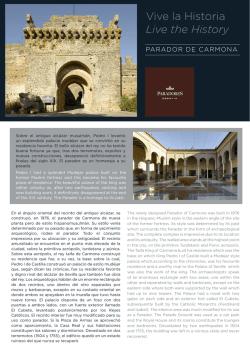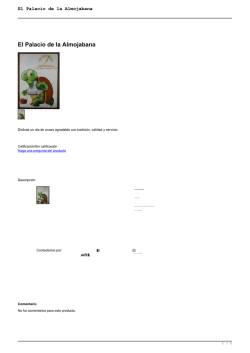
Folleto Vive la Historia. Parador de Olite
Vive la Historia Live the History PARADOR DE OLITE Uno de los conjuntos gótico-civiles más bellos de Europa se encuentra en Olite. Allí estuvo el palacio de los reyes de Navarra cuya parte más antigua se ha habilitado como parador. Su caprichoso y anárquico perfil lleno de recovecos, torres, almenas, galerías y jardines es una pura evocación de la Edad Media. One of the most beautiful Civil-Gothic complexes in Europe is in Olite. There was the Palace of the Kings of Navarre whose oldest part has been fitted out as a Parador. Its capricious and anarchic profile full of nooks, towers, battlements, galleries and gardens are simply an evocation of the Middle Ages. El parador corresponde a la parte más antigua de todo el conjunto palaciego, el llamado Palacio Viejo o de los Teobaldos. Estamos ante un espacio habitado desde los romanos, cuyos restos arqueológicos asoman en algunas de las torres. El “praesidium” romano fue el núcleo del palacio hasta que, en la Edad Media, Carlos III de Navarra lo amplió y lo convirtió en uno de los palacios más bellos de Europa, adosándole a él el llamado Palacio Nuevo. El viejo palacio medieval estaba estructurado en torno a un patio interior rodeado por dependencias auxiliares, reservándose la primera planta para las estancias reales. Cuando el reino de Navarra fue incorporado a la unión peninsular en 1512 los palacios, tanto el viejo como el nuevo, perdieron su condición de reales y empezó su decadencia. Durante la guerra de la independencia fue prácticamente incendiado y, a principios del siglo XX sólo se conservaban las dos torres orientales y los muros exteriores. En 1966 comenzó su reforma para adaptarlo a parador de turismo. Se reconstruyó el patio partiendo sólo de cimentaciones y, gracias a la documentación, se pudieron reconstruir los ventanales góticos de la fachada. El resultado final fue un pequeño parador de 800 metros de planta con apenas 14 habitaciones y zonas comunes. Debido a su insuficiente tamaño se creó un anexo diferenciado para las habitaciones unido por una logia en un estilo similar al conjunto palaciego. The Parador corresponds to the oldest part of all the palace complex, the so-called Palacio Viejo or Palacio de los Teobaldos. This area has been inhabited since the time of the Romans, whose archaeological remains appear in some of the towers. The Roman “praesidium” was the nucleus of the palace until, in the Middle Ages, Carlos III of Navarre extended it and transformed it into one of the most beautiful palaces in Europe, attaching it to what was called the New Palace (Palacio Nuevo). The old medieval palace was structured around an interior patio surrounded by auxiliary dependencies, with the first floor reserved for the royal rooms. When the Kingdom of Navarre was incorporated into the peninsular union in 1512, both the old and new palaces lost their condition of royal and their decadence began. During the War of Independence, it was practically burned down and, at the beginning of the XX century, only the two eastern towers and the exterior walls were conserved. The reform work to adapt it to a Parador of Tourism began in 1966. The patio was rebuilt starting only from the foundations and, thanks to the documentation, it was possible to reconstruct the Gothic windows of the façade. The final result was a small Parador with a surface area of 800 metres and 14 bedrooms and common areas. Owing to its insufficient size, a differentiated annex was created for the bedrooms joined by a loggia in a style similar to the Palace complex. CARLOS DE VIANA, UN PRÍNCIPE INFORTUNADO Aunque el príncipe Carlos nació en Peñafiel en 1421, se crió en el palacio real de Olite donde su abuelo, el rey Carlos III de Navarra, le consideró su sucesor creando para él el título de príncipe de Viana y educándole como a un futuro rey. Su destino, sin embargo, fue muy distinto. Aunque era el legítimo heredero del trono navarro como hijo de la reina Blanca, sus permanentes disputas con su padre, que nunca le quiso reconocer como rey, decidieron su futuro. Además, su padre tras enviudar de la reina Blanca se volvió a casar con una castellana que siempre intentó que los derechos de su hijo, el futuro rey Fernando el Católico, prevaleciesen sobre los de su hijastro Carlos. El carácter indeciso y excesivamente prudente de éste y las tensiones políticas de la época precipitaron su final. Su muerte prematura y su triste destino le convirtieron en un personaje romántico que el siglo XIX engrandeció en el arte y la literatura. JOSÉ MORENO CARBONERO, El príncipe don Carlos de Viana (Museo Nacional del Prado) CARLOS DE VIANA, AN UNFORTUNATE PRINCE Although Prince Carlos was born in Peñafiel in 1421, he was brought up in the Royal Palace of Olite where his grandfather, King Carlos III of Navarre, considered him to be his successor and created the title of Prince of Viana for him and educated him as a future king. However, his destiny was very different. Although he was the legitimate heir to the throne of Navarre as the son of Queen Blanca, his permanent disputes with his father, who never wanted to recognise him as king, decided his future. Moreover, after becoming a widower on the death of his wife, Queen Blanca, he married again this time to a Castilian, who always endeavoured that the rights of her son, the future king Ferdinand of Aragon, should prevail over those of her stepson Carlos. The indecisive and excessively prudent character of Carlos and the political tensions of the epoch precipitated his end. His premature death and his sad destiny transformed him into a romantic personage which the XIX century magnified in art and literature. LAS TORRES DEL VIEJO PALACIO Olite es famosa por su perfil caprichoso e irregular. Sólo en el palacio que hoy es parador hay tres torres distintas. En la esquina nororiental, la torre de la prisión, almenada y antigua sala de armas de la guardia; en la esquina suroriental, la torre de San Jorge, también almenada y donde Sancho el Fuerte construyó una pequeña capilla. En la fachada principal se levanta la más alta torre, la de las cigüeñas, antigua atalaya, de planta cuadrada y rematada por una pequeña torre circular. THE TOWERS OF THE OLD PALACE Olite is famous for its capricious and irregular profile. The Palace alone, which is today the Parador, has three different towers. In the north east corner, the tower of the prison, with its battlements and ancient guard armoury; in the south east corner, the Tower of San Jorge, also with its battlements and where Sancho el Fuerte built a small chapel. The highest tower is in the main façade, the Tower of the Storks (Torre de las Cigueñas), an ancient watchtower, with a square layout and crowned by a small circular tower. TAMBIÉN LE GUSTARÁ: YOU WILL ALSO LIKE THE FOLLOWING: Paseo a pie por Olite y el Palacio Nuevo. Walking through Olite and the New Palace Ruta real de Navarra (Olite-Ujué-Oliva-Valdorba). The Royal Route of Navarre (Olite-Ujué-Oliva-Valdorba) Pamplona. Pamplona Categoría: Palacio Fecha: 1966 Arquitecto: Ignacio Gárate BIC: Monumento Category: Palace Date: 1966 Architect: Ignacio Gárate BIC (Property of Cultural Interest): Monument
© Copyright 2025

